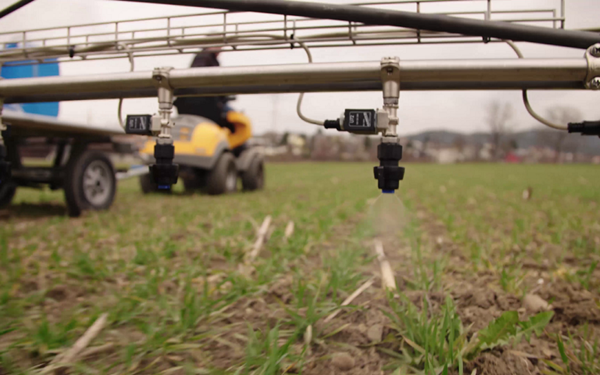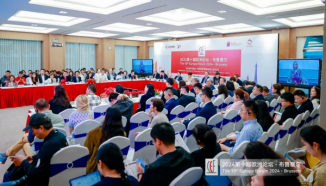Huawei works with partners to facilitate smart agriculture in Switzerland
fenaco, Agroscope, the OST (Eastern Switzerland University of Applied Sciences), Sunrise UPC and Huawei are bundling their expertise to drive 5G-based smart technologies for Swiss agriculture. Together, they are realizing an Innosuisse project that revolves around controlling weeds using drones and agricultural robots. In relation to this project, the Smart Farming division – situated in the Joint Innovation Center of Sunrise UPC and Huawei – was expanded. This division demonstrates relevant applications. It also takes technologies aimed at increasing sustainability and efficiency in agriculture and makes the benefits they provide tangible.

5G enables precise spraying of herbicides
The experts from fenaco, Agroscope, the OST, Sunrise UPC and Huawei all agree that technological innovations are required to deliver sustainable agriculture. Thanks to the low latency, transmission of immense data volumes, and massive simultaneous connections, 5G is ticking the boxes required for the Internet of Things to make its mark in the field of agriculture. In combination with other technologies, applications are becoming possible that reduce the environmental impact of pesticides, conserve natural resources, improve animal welfare, and generate higher yields for farmers – all the while helping them save on costs.
Innosuisse project: Controlling weeds using drones and agricultural robots
Using an Innosuisse project for weed detection and control as a model, the five partners want to test the combination of these technologies. This project focuses specifically on the so-called "bitter dock", a species of dock that displaces other plants. The plants are photographed by drone and the raw data are uploaded to the cloud via 5G data connections. There, they are analyzed and identified in real time. The results are played back in the field, where a tractor or agricultural robot is navigated to the weeds via GPS in order to combat them. Weed control is carried out very precisely using this procedure. Pesticide use can be reduced by up to 90%. A further developmental step will involve replacing the pesticide with hot water. The use of neural networks and self-learning algorithms is making plant recognition more and more precise. At the same time, this is causing data volumes to increase immensely. The combination of 5G and other technologies is therefore essential to the success of this innovative project.
Big data and 5G are paving the way for data-based agriculture
Thomas Anken, Head of Digital Production at Agroscope, sees great potential in 5G and data-driven agriculture: "In the future, the agriculture industry will be a more data-based one. When it comes to the central evaluation of decentrally collected data, fast and high-volume data transmission is crucial. In this regard – and also when it comes to controlling and monitoring autonomous devices – good connectivity, which only 5G can provide, is essential."
Michael Feitknecht, Head of the Plant Production Department and Member of the Management Board at fenaco, adds, "The combination of digitization and alternative plant protection is enabling us to create sustainable solutions to the current challenges faced by the agriculture industry. For example, parasitic wasps from fenaco are already protecting 15% of Swiss corn from the European corn borer. 40% of these wasps are sent out via drones. We hope that the Innosuisse project will provide a further boost to digitization within Swiss agriculture and reduce the risks associated with the use of pesticides in our fields."
Dejan Seatovic, Institute Partner at the ILT Institute for Lab Automation and Mechatronics and Professor of Machine Technology and Innovation at the OST in
Rapperswil, is certain: "The developments in autonomous driving that we are working on will only be practicable with an expansion of 5G infrastructure. We are still in the early stages of developing autonomous, collaborative robotic systems aimed at improving ecology and efficiency. Our goal is the automation and digitization of farm work and processes in order to deliver a sustainable future for Swiss agriculture."
Alexander Lehrmann, Innovation and Development Leader at Sunrise UPC, explains, "With our 5G ecosystem, we are complementing and augmenting farmers' practical knowledge and many years of experience. We see Sunrise UPC as an 'Innovation Enabler' that, in close cooperation with industry experts, examines the possible uses of technologies – and interplay between them – while designing and implementing integrated solutions. Thanks to an excellent level of cooperation between research units, providers, and users, innovation can be driven to the benefit of everyone."
Wang Haitao, CEO of Huawei Switzerland, says, "5G is an optimum solution to requirements like the ones described. With 5G, even the most remote areas of Switzerland can be networked and connected to a sustainable infrastructure. In this way, our technologies are contributing towards the digitization of Switzerland and increasing the competitiveness of one of its most traditional industries. This is something that makes us very proud."

 Login
Login Login
Login CCCEU and Gunnercooke Successfully Host Webinar on CSDDD and FLR Compliance to Guide Chinese Businesses
CCCEU and Gunnercooke Successfully Host Webinar on CSDDD and FLR Compliance to Guide Chinese Businesses Cultivating responsible China-EU business leaders essential to tackling global challenges
Cultivating responsible China-EU business leaders essential to tackling global challenges



